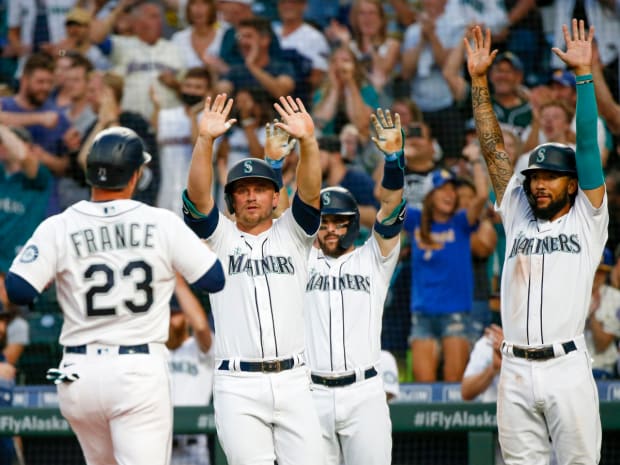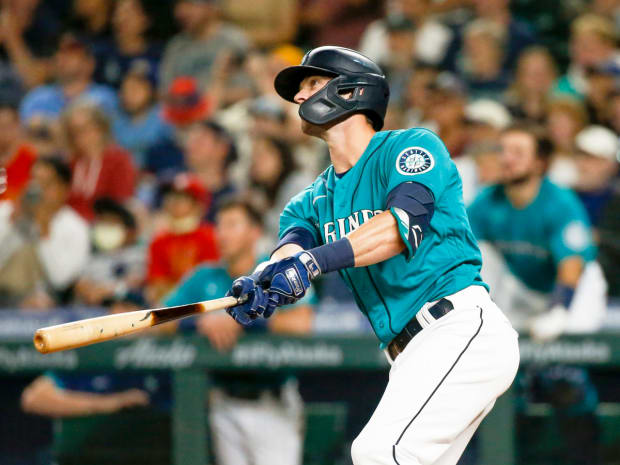Seattle's success in one-run games is an anomaly. Then again, so is a playoff drought that’s nearly old enough to drink.
Welcome to The Opener, where every weekday morning you’ll get a fresh, topical column to start your day from one of SI.com’s MLB writers.
The Mariners’ 4–2 win over the Rays on Tuesday night was downright boring by their standards: There was no late-inning comeback or tightrope-walking by the bullpen, and the two-run margin of victory qualified as a blowout compared to how the 2021 season has progressed thus far. A few more ho-hum wins like that, though, and Seattle could find itself in a position it hasn’t occupied in a great many years: smack-dab in the middle of the playoff picture.
The Mariners have not made the postseason since 2001, earning them the dubious distinction of having the longest active postseason drought in major North American sports. In the 19 years between Seattle’s last playoff appearance and this year, the team has had a dozen losing seasons, including a pair of 101-loss campaigns in '08 and '10.
Every other club has made the playoffs at least twice in that span, and 27 have reached the postseason at least three times. Thirteen different teams have won a World Series championship and none have gone back-to-back. In an era of true parity, the Mariners are time and time again the ones left standing without a chair when the music stops playing.

Seattle’s surge over the past month and a half has the team just two games back of the A's for the second wild-card spot, but you wouldn’t know it based on FanGraphs’ playoff odds, which give the Mariners a mere 3.9% chance at making the postseason after Tuesday’s victory. Baseball Reference is only slightly more bullish at 5.9%. By comparison, FanGraphs gives the Yankees—who are currently tied with Seattle—a whopping 52.8% chance at getting to the playoffs, while the Blue Jays’ odds sit at 38.1%.
The reason for such a wide disparity is not an East Coast bias, but one that’s been brought up several times by yours truly throughout the season: Seattle’s run differential, a supposed “true” reflection of a team’s caliber. The Mariners have been outscored by 48 runs this season—the same amount as the Tigers and worse than the Cubs, Nationals and Marlins.
Getting outscored in the aggregate does not typically portend sustained success. Modern-day front offices, after all, view player acquisitions in terms of buying runs, and allowing more runs than you score over the course of the season would seemingly be a hindrance to long-term success. That logic makes sense and typically holds true, but the Mariners have bested those expected outcomes by putting up a remarkable 23–10 record in one-run games this year.
There’s no secret sauce to having sustained success in one-run games, but a reliable bullpen is as good a place as any to start. Seattle’s relievers, a group of mostly anonymous pitchers on relatively low salaries, has been an absolute boon so far this season. The group ranks third in the majors in fWAR (4.7) and seventh in win probability added (3.61), and just upgraded at closer by landing Diego Castillo in a trade with Tampa Bay.
While the bullpen has been stellar in crunch time, Seattle’s offense has risen to the occasion in those moments as well. For the season, the Mariners rank 28th in on-base percentage (.299) and are tied with the Cubs for the second-highest strikeout rate (26.0%) in the majors. Yet Seattle hitters blow away the competition when it matters most, batting .285 with a 138 wRC+ in high-leverage situations—that’s 19 points higher than the second-best team (Phillies). The Astros, the next-best AL team, has a 113 wRC+ in high-leverage situations.
If this tune sounds familiar to Mariners fans, it should. The 2018 team went 89–73 despite having a -34 run differential. Just like this season, Seattle rode a hot streak of one-run victories early on in the year to remain in the hunt and outperform preseason expectations. Those Mariners beat the Giants, 3–2, on July 25 to improve to 61–41 and remain in sole possession of the second wild-card spot, but the team faded from there and went 28–32 the rest of the way to miss the playoffs by eight games.
From Opening Day that season to July 25, the Mariners were 27–13 in one-run games. From that point on, they had a 9–8 record in such games—hardly a debacle but a relative crash down to Earth following a nearly unprecedented hot streak.
Will the one-run luck run out again this time? Mariners fans will be quick to point out that the ticket to entry into the playoffs is wins, not just a running total of runs. And while that’s true, there is scarce precedent for what Seattle is trying to pull off.

Since the start of the wild-card era in 1995 (and excluding last season’s expanded playoff field), only three teams have made the postseason with a negative run differential: the 1997 Giants, 2005 Padres and 2007 Diamondbacks. None of those three teams won the pennant, though Arizona did make the NLCS that year (strangely enough, the Diamondbacks were actually the NL’s No. 1 seed in the playoffs, as all four qualifying teams had between 85 and 90 wins).
If the Mariners do pull off the incredible, they’ll make history in the process. This team has obvious flaws that would prohibit it from doing so—most of which have been overcome to this point—but better play will likely be needed for the Mariners to catch Oakland.
Something’s got to give over the next two months: either the statistical anomaly of Seattle’s one-run magic, or a playoff drought that’s nearly old enough to drink. Given the history of teams that get outscored, the odds of Seattle's pulling off a run for a wild-card spot aren’t great. Then again, neither are the chances of missing the playoffs for nearly two whole decades.
The Mariners should not be where they are today, and yet here they sit, firmly in the hunt for a prize that’s eluded them for the better part of this century. The best path forward over the next 54 games is not to consider the weight of the franchise’s recent failures and trying to end the dry spell. As clichéd as it sounds, Seattle will proceed as it has all season: one game—and one run—at a time.
More MLB Coverage:
• Breaking Down the NL East Race After a Chaotic Trade Deadline
• How Baseball's Superteam Can Still Be Stopped
• Chaotic Trade Deadline Changed the Game
• MLB Trade Deadline Winners and Losers